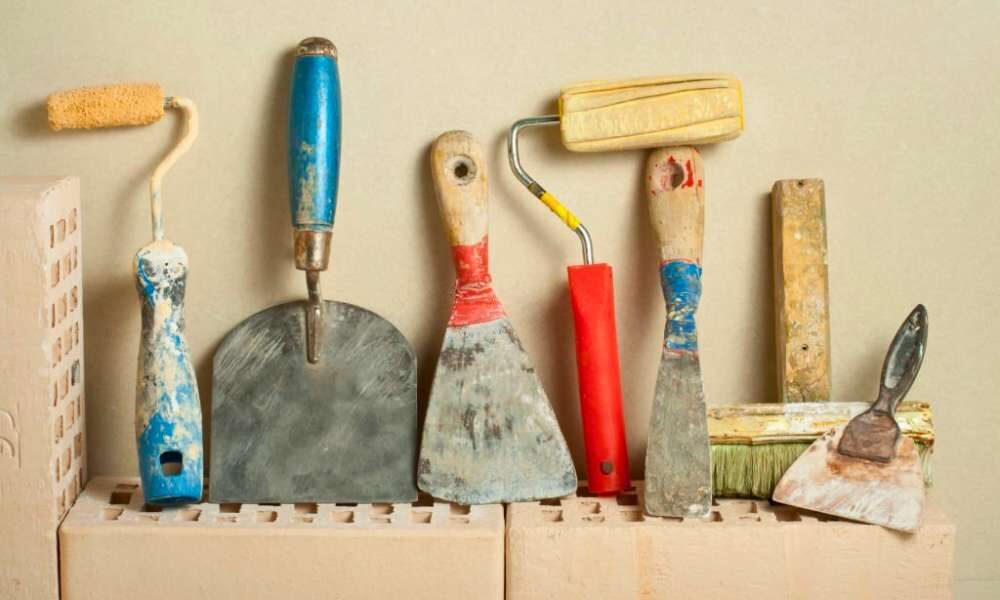When it comes to bricklaying, having the right tools is essential for achieving quality results. Whether you’re a professional bricklayer or a DIY enthusiast, understanding and utilizing the ten necessary bricklaying tools discussed below can make a significant difference in the efficiency and outcome of your projects. From trowels and brick hammers to spirit levels and line blocks, each tool specifically ensures precise, level, and visually appealing brickwork. Let’s explore these top 10 types of bricklaying tools that are essential in detail and understand their importance in bricklaying.
1. Trowel
A trowel is a handheld tool with a flat, pointed blade. It is the primary use for spreading and shaping mortar during bricklaying-by-bricklaying contractors. The blade’s flat surface allows for even distribution of artillery, while the pointed tip helps maneuver and apply mortar in tight spaces. Trowels come in different sizes, and selecting the proper size depends on the scale of the bricklaying project.
Trowels are indispensable for professional bricklaying contractors, including those at TBFC Bricklaying Contractors. With their expertise and experience, these contractors understand the importance of using the proper trowel for each job. TBFC Bricklaying Contractors rely on high-quality scoops to ensure precise mortar application and seamless brickwork, whether a large-scale construction project or a minor repair job. By investing in top-notch bricklaying tools, such as trowels, these contractors can deliver exceptional results that meet the highest standards of craftsmanship and customer satisfaction.
2. Brick Hammer
Also known as a bricklaying hammer or a masonry hammer, this tool is specifically designed for cutting bricks and breaking them into smaller pieces when required. It typically has a chisel-like edge on one side for cutting bricks and a blunt end on the other for breaking them. The brick hammer is crucial for accurately shaping bricks to fit corners or edges.
3. Spirit Level
A spirit level is a tool to ensure that the bricks are laid horizontally and vertically, maintaining a straight and level course during construction. It consists of a long, rectangular body filled with liquid and an air bubble. When the bow is centered between two parallel lines inside the level, it indicates that the surface is level. Spirit levels are essential for achieving accurate brickwork and maintaining structural integrity.
4. Brick Jointer
A brick jointer is a small metal tool with a curved or V-shaped end. It is used to create a concave joint between bricks. After laying the bricks, the jointer is pressed against the mortar joint, shaping it into an open form. This enhances the brickwork’s visual appeal and improves its strength by allowing better mortar adhesion.
5. Brick Tongs
Brick tongs are specialized gripping tools used for lifting and carrying bricks without straining the back or causing damage to the hands. They have two handles and adjustable jaws that securely grip the bricks, making transporting them around the worksite easier. Brick tongs provide a safer and more efficient way to handle heavy bricks.
6. Line Blocks
Line blocks are small, rectangular-shaped blocks made of wood or plastic. They play a crucial role in ensuring straight and level courses of bricks. Line blocks hold the brick line (string) in place. The series is stretched tightly between two-line blocks, serving as a guide for laying bricks in a straight line. By maintaining the alignment of the bricks, line blocks contribute to the overall quality and appearance of the brickwork.
7. Mason’s Chisel
A mason’s chisel is a sharp, pointed tool for cutting bricks or shaping them to fit specific areas. It features a beveled cutting edge that allows for precision cutting and shaping of bricks. Mason’s chisels are particularly useful when working on intricate details or adjusting brick sizes during construction.
8. Joint Raker
A joint raker, also known as a brick jointer or jointing iron, removes excess mortar between the bricks. After the mortar has been partially set, the joint raker is dragged along the joints to scrape away any extra material. This process helps create a uniform and clean joint, ensuring a professional finish to the brickwork.
9. Mason’s Line
A mason’s or brick line is a strong nylon string used to ensure the straightness and alignment of bricks. It is stretched tightly between two-line blocks and acts as a guide for laying bricks in a straight line. Mason’s lines are crucial for maintaining the overall level and straightness of the brickwork, especially for larger projects.
10. Mortar Board
A mortar board is a flat, portable surface, typically wood or plastic. It uses to hold and mix mortar conveniently during bricklaying. The mortarboard allows bricklayers to mix the cannon to the desired consistency by providing a clean and spacious working area. It also prevents the mortar from spilling or drying out too quickly, ensuring efficient bricklaying operations.
Wrapping Up
In bricklaying, the right tools are indispensable for creating sturdy, straight, and aesthetically pleasing structures. The top 10 types of essential bricklaying tools discussed in this article, including trowels, brick hammers, spirit levels, brick jointers, brick tongs, line blocks, mason’s chisels, joint rakers, mason’s lines, and mortar boards, each play a crucial role in different aspects of the bricklaying process. By hiring TBFC Bricklaying Contractors bricklayers can achieve efficient and professional results, whether constructing large-scale projects or engaging in smaller DIY endeavors. Investing in high-quality tools and understanding their functions is vital to unlocking the potential of bricklaying and bringing your vision to life, brick by brick.




